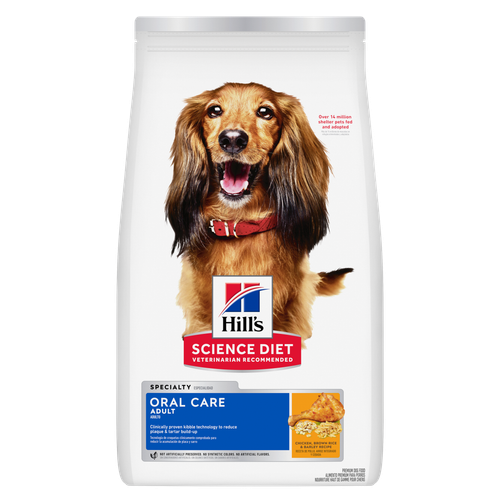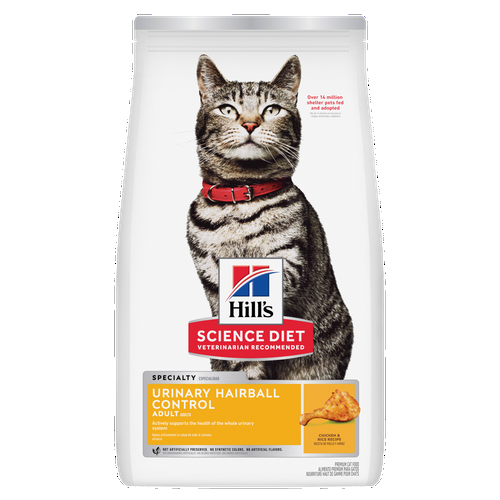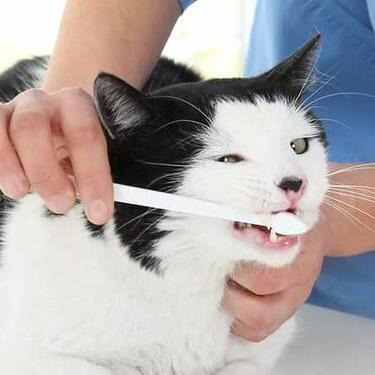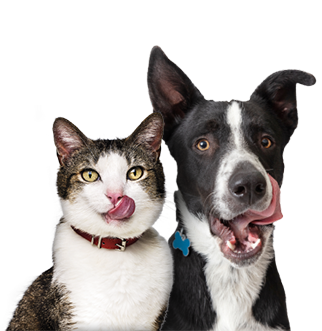
-
Find the right food for your petTake this quiz to see which food may be the best for your furry friend.Find the right food for your petTake this quiz to see which food may be the best for your furry friend.Featured products
 Adult 7+ Small & Mini Chicken & Brown Rice Recipe Dog Food
Adult 7+ Small & Mini Chicken & Brown Rice Recipe Dog FoodFor the unique nutritional needs of mature Small & Mini dogs
Shop Now Hill's Science Diet Adult Oral Care Chicken, Brown Rice & Barley Recipe Dog Food
Hill's Science Diet Adult Oral Care Chicken, Brown Rice & Barley Recipe Dog FoodClinically proven kibble technology to reduce plaque & tartar build-up
Shop Now Adult Small & Mini Lamb Meal & Brown Rice Recipe Dog Food
Adult Small & Mini Lamb Meal & Brown Rice Recipe Dog FoodFor the faster metabolism of Small & Mini dogs
Shop NowFeatured products Hill's Science Diet Adult Sensitive Stomach & Skin Dog Food
Hill's Science Diet Adult Sensitive Stomach & Skin Dog FoodHighly digestible recipe, gentle on stomachs. Nourishes skin & promotes a lustrous coat
Shop Now Adult Urinary Hairball Control Chicken & Rice Recipe Cat Food
Adult Urinary Hairball Control Chicken & Rice Recipe Cat FoodActively supports the health of the whole urinary system
Shop Now Adult Indoor Chicken Recipe Cat Food
Adult Indoor Chicken Recipe Cat FoodSupports energy level and beautiful fur in indoor cats
Shop Now -
Featured articles
 Easy DIY Dog & Cat Toys: Nine of Our Favorites
Easy DIY Dog & Cat Toys: Nine of Our FavoritesBrowse this comprehensive guide for several of our favorite DIY dog and cat toys that are sure to put a little pep in your pet's step.
Read More 15 Pet-Friendly Cities Ideal for a US Road Trip
15 Pet-Friendly Cities Ideal for a US Road TripCheck out our list of pet-friendly U.S. cities that are excellent travel options, offering off-leash dog parks and pet-friendly restaurants & hotels.
Read More My Pet Ate a Lizard — What Should I Do?
My Pet Ate a Lizard — What Should I Do?Learn what to do if your pet eats a lizard, including whether they can be toxic and symptoms to keep an eye on when they've swallowed one.
Read More -


Like most topics these days, pet nutrition has become a little polarizing. With all the trends and changes in pet food, it can be difficult to know who or what to trust. All you want to do is find the best for your dog or cat, so why does it have to be so complicated?
We hear you. At Hill’s, our commitment isn’t in the various trends our competitors are peddling, but in the scientific data gathered from years of ongoing veterinary and nutritional research. Every Hill’s pet food is a collaboration between vets, scientists and pet nutritionists to ensure we are providing the best pet food for your dog or cat.
So, what does all this really mean? Well, it starts with a process called predictive biology. If you’re not a scientist or pet nutritionist, fear not — here’s our process behind making healthy, biology-based pet food products.
Research

Before any dog or cat food ever gets made, we refer to our never-ending study of pet biology. Just like humans, the biology of dogs and cats is the blueprint behind your pet’s life and their roadmap into a fully-grown pet. Learning about a pet’s inner processes, organs, neurological system, blood, reproduction, development, and diseases all prove essential for developing nutrition to optimize their health and well-being.
That’s where predictive biology comes into play — it's a comprehensive approach used to understand your pet's biology. We study how different ingredients and nutrients have an essential role in your pet’s biology and determine how they play a role in their biologic processes. We can break this research into three different areas:
Genetics
As any high school science teacher might explain, genes (made up of DNA) are the code or instructions needed to make the proteins and molecules essential for growth, development and health in all living things. DNA is what controls how big your dog will get, what color your cat will be, what health conditions your pet might be predisposed to, and just about everything else. Studying the genetic makeup of pets allows us to understand what pieces of their DNA are associated with certain traits and what role they play in a dog or cat’s health.
A pet’s DNA plays a huge role in nutrition, too. It influences your pet’s hormones, enzymes, and proteins that help create organs and tissues, digest their food and control their metabolism. Genetic research helps us to determine how a pet will react to certain ingredients and nutrients. This research tells us how your pet will metabolize (break down) certain foods and not others. For instance, genetics is why you can enjoy chocolate as a tasty treat, but it is toxic to a dog or cat.
So, how do we study pet DNA? We begin by taking a swab of a dog or cat’s cheek and look at the cells within the sample. With the help of some sophisticated machines, we are able to extract the DNA from the cells and study it. Through careful mapping, we are able to determine which pieces of a pet’s DNA affects which trait in their biology.
Genomics
Genomics is the study of how ingredients and nutrients affect the genes of a living organism; in Hill’s case, pets. Different ingredients and nutrients have the ability to change gene’s activity or gene expression, which is why it is so important to study this before ever formulating a pet food.
Think of genomics like a dimmer switch on lights: we observe which nutrients can change the activity of genes in a metabolic pathway either by lowering their activity (dimmer) or increasing their activity (brighter). By studying how genes react to different nutrients, we can determine the biological effects of our pet food formulations. So how do we do this? We can look at effects of ingredients and nutrient on gene expression either in cells in culture in the lab or by feeding the pet.

All of this helps determine which ingredients and nutrients should go into every bag, pouch and can of Hill’s Pet Foods.


Tasty Tips
Young pets may need several visits in their first year for vaccinations. Adult pets generally benefit from annual check-ups, while senior or special-needs pets might require more frequent visits.
Microbiomics
The last method of research in understanding a pet's biology is the study of microbiomics — the study of how bacteria inside your pet affect their health. When it comes down to it, we’re not just feeding your pet — we’re also feeding the bacteria inside of your pet.
Like all living organisms, dogs and cats have millions of bacteria growing in and on their bodies; in this community of bacteria, some have good effects for the pet, and some don’t. By studying these tiny microbes, we can determine which bacteria are important and what they are doing and if it has a positive or negative effect on your pet’s health.
So, what does this determination process look like? We typically start by collecting stool samples of pets to examine the bacteria found inside. This gives us a good indication of the microbes that live inside a pet’s gastrointestinal tract. The microbes are then mapped against a global database of known bacteria.
By understanding what microbes live inside your pet, we can formulate healthy pet food that supports the beneficial bacteria a pet needs and influence the microbiome to help them stay healthy.
Formulation
The data that all of our scientists and nutritionists compile is the basis of how we create a Science Diet® pet food. Whether we’re creating better hairball control for your feline friend, or supporting healthy brain function for an older dog, the process of predictive biology is how we ensure their food is effective.

But healthy foods have to be tasty too, and we put in just as much research effort to understand what pets love to eat to ensure our recipes taste delicious. Dogs and cats are our consumers. When we develop our innovative nutritional products, we conduct taste preference tests to let the dogs and cat choose which recipe is best at our Global Pet Nutrition Center (PNC). Our pet partners at the Pet Nutrition Center have a great home with optimal care. We provide our pets with quality nutrition, mental and physical exercise, excellent veterinary care, socialization with other pets and people and lots of love every day. We believe that the ability to choose and have flexibility in how they spend their free time is important to their overall health and wellbeing. Many of our pet partners are enrolled in taste preference evaluations where they are allowed to choose from one of two meals and decide which one they prefer. This helps our product developers design foods that are nutritious and delicious.
No matter what you feed your dog or cat, we know that you love them and are looking to do what is best for them. That’s the same feeling that launched Hill’s Pet Nutrition over 70 years ago, and why we tirelessly spend time researching and innovating new ways to make your pet healthier and happier. When it comes to Science Diet pet foods, it all starts with science to help us create a biology-based nutrition that your dog or cat is sure to love.
Related products

Improves everyday ability to get up & go

For the faster metabolism of Small & Mini dogs

For the unique nutritional needs of mature Small & Mini dogs

Clinically proven kibble technology to reduce plaque & tartar build-up
Related articles

Learn what to do if your pet eats a lizard, including whether they can be toxic and symptoms to keep an eye on when they've swallowed one.

Learn about veterinary dental care for your pet, including deep teeth cleaning procedures, which can help your dog or cat maintain proper dental health.

Browse this comprehensive guide for several of our favorite DIY dog and cat toys that are sure to put a little pep in your pet's step.

Check out our list of pet-friendly U.S. cities that are excellent travel options, offering off-leash dog parks and pet-friendly restaurants & hotels.

Put your pet on a diet without them knowing
Our low calorie formula helps you control your pet's weight. It's packed with high-quality protein for building lean muscles, and made with purposeful ingredients for a flavorful, nutritious meal. Clinically proven antioxidants, Vitamin C+E, help promote a healthy immune system.
Put your pet on a diet without them knowing
Our low calorie formula helps you control your pet's weight. It's packed with high-quality protein for building lean muscles, and made with purposeful ingredients for a flavorful, nutritious meal. Clinically proven antioxidants, Vitamin C+E, help promote a healthy immune system.

